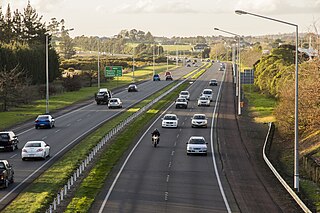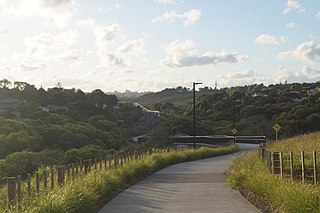
Panmure is an east Auckland suburb, in the North Island of New Zealand. It is located 11 kilometres southeast of the Auckland CBD, close to the western banks of the Tāmaki River and the northern shore of the Panmure Basin. To the north lies the suburb of Tāmaki, and to the west is the cone of Maungarei / Mount Wellington.
Botany Town Centre is a large shopping mall and lifestyle centre located in Auckland, New Zealand. It has more than 200 stores spread across three complexes, including restaurants and entertainment buildings such as cinemas. It is situated at the corner of Ti Rakau Drive and Chapel Road in the suburb of East Tāmaki, and was opened in 2001.

Māngere Bridge, officially also called the Manukau Harbour Crossing, is a dual motorway bridge over the Manukau Harbour in south-western Auckland, New Zealand, crossing between the suburb also known as Māngere Bridge and the suburb of Onehunga.

Glen Innes railway station is located on the North Island Main Trunk line in New Zealand. Eastern Line services of the Auckland railway network are the only regular services that stop at the station. It has an island platform layout. Every hour it has at least three services towards Manukau and at least three towards Britomart. In 2006 the station had a major upgrade and is one of the most used non-terminus stations by the public.

The Central Motorway Junction or CMJ, is the intersection of State Highways 1 and 16, just south of the central business district of Auckland. A multilevel structure, it has been described as a "fiendishly complicated, multi-layered puzzle of concrete, steel and asphalt". Carrying around 200,000 vehicles a day, it is one of the busiest stretches of road in New Zealand.

The Northern Busway is a segregated busway that runs along the eastern side of the Northern Motorway, part of State Highway 1, in the north of Auckland, New Zealand, linking the North Shore with the northern end of the Auckland Harbour Bridge. As of May 2022, the busway consists of two-way lanes running between Albany Station and Akoranga Station, and from Akoranga Station a southbound-only lane that joins the harbour bridge approaches just south of the Onewa Road on-ramp system. Between 2008 and 2022 the busway terminated at Constellation.
Transport in Auckland, New Zealand's largest city, is defined by factors that include the shape of the Auckland isthmus, the suburban character of much of the urban area, a history of focusing investment on roading projects rather than public transport, and high car-ownership rates.

The Auckland isthmus, also known as the Tāmaki isthmus, is a narrow stretch of land on the North Island of New Zealand in the Auckland Region, and the location of the central suburbs of the city of Auckland, including the CBD. The isthmus is located between two rias, the Waitematā Harbour to the north, which opens to the Hauraki Gulf / Tīkapa Moana and Pacific Ocean, and the Manukau Harbour to the south, which opens to the Tasman Sea. The isthmus is the most southern section of the Northland Peninsula.

The Central Connector, is a bus route between Britomart Transport Centre in the Auckland CBD, New Zealand, and the commercial suburb of Newmarket. It has some aspects of a bus rapid transit link. It was expected to improve journey times by about 14 minutes for around 2,600 buses per week, about 65,000 passengers daily. Work began in April 2008 and is now finished.

The Auckland Northern Motorway in the Auckland Region of New Zealand links Central Auckland and Puhoi in the former Rodney District via the Hibiscus Coast and North Shore. It is part of State Highway 1.

The Auckland Southern Motorway is the major route south out of the Auckland Region of New Zealand. It is part of State Highway 1.

Public transport in Auckland, the largest metropolitan area of New Zealand, consists of three modes: bus, train and ferry. Services are coordinated by Auckland Transport under the AT Metro brand. Britomart Transport Centre is the main transport hub.

The Eastern Line is the name of the suburban rail service in Auckland, New Zealand between Britomart and Manukau via the North Island Main Trunk (NIMT) and Manukau Branch. Services are operated by Auckland One Rail under the Auckland Transport brand.

The Northwestern Cycleway is a 12 km mostly off-road cycle route in New Zealand that connects the Auckland CBD with the suburb of Westgate. For most of its length, it runs alongside the Northwestern Motorway.

The Waikaraka Cycleway is an off-road cycleway in the south of the Auckland isthmus, New Zealand, running from the suburb of Wesley along New Zealand State Highway 20 to Onehunga and then continuing along the shoreline of the Manukau Harbour beside mostly industrialised areas until it ends at Hugo Johnston Drive, in Southdown.
The North Auckland and Northland (NAaN) grid upgrade project reinforced transmission into the Auckland Region and across the harbour to North Auckland and the Northland Region. It added new 220 kV transmission capacity to the National Grid by providing 37 km of underground cable between the Pakuranga, Penrose, and Albany substations.

The Auckland Airport Line was a proposed heavy rail line in Auckland, New Zealand, that would have linked Auckland Airport with the Auckland central business district via central isthmus suburbs.

The Eastern Busway, also known as AMETI, is Auckland's first urban busway under construction in the southeastern suburbs of Panmure, Pakuranga and Botany, in Auckland. The first section of the busway, between Panmure and Pakuranga, opened in December. The entire project is expected to be complete by 2026.

Te Ara ki Uta ki Tai, also known as the Glen Innes to Tāmaki Drive shared path, is a shared pathway connecting the suburbs of Ōrākei and Glen Innes in Auckland, New Zealand. It runs through the Pourewa Valley and the Eastern Transport Corridor, and for most of its length is adjacent to the North Island Main Trunk railway line.

Hobson Bay is a bay in the Auckland Region of New Zealand's North Island. It is located to the east of the Auckland City Centre, and is bisected by the Eastern Line and Tamaki Drive.


















